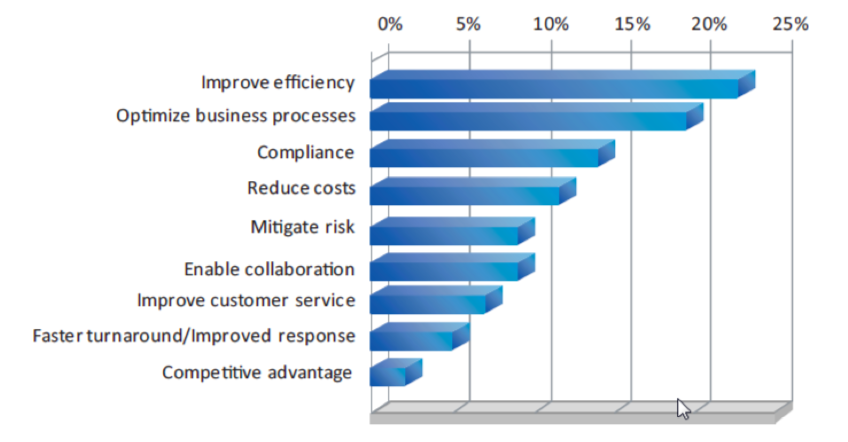As information and data are both on a staggering rise, the Enterprise Content Management requirement and market is worth a discussion. The ultimate goal of deploying content management systems within the enterprise is to create workflows and improve efficiency in a wide-spread organisations with a lot of people in the workforce.
CMS vs ECM
A Content Management System is generally used to create, manage, and publish content in a consistently organized fashion using web and IP technology.
Overleaf, an ECM is a compound software used to manage, store, capture and deliver documents and related content as per requirements throughout the organisational processes. An ECM helps the organisation in structuring the clustered bundle of information and making it more accessible to company wide employees for business purposes.
Here are some factors which are driving more ECM rollouts:
The rising struggle to effectively manage, collaborate and make use of the several huge piles of documents and data has led organisations to plan out a successful ECM deployment. Organisations want to streamline information management and achieve supreme operational efficiency.

Reason 1 - Productivity Loss & Bucks down the drain
The IDC & Butler group found out that knowledge workers spend an average of 8.8 hours per week or even more to get a hand of the right information. Any organisation can put this into numbers by calculating their workforce, payroll and work hours altogether.
Supposedly, Company X employs 500 knowledge workers at a CTC of $70,000 annually, 8.8 hours per week costs the company $13,209 per year from a single employee. That makes $ 66,04,500 p.a sweep into the drain.
This degree of inter-organisational inefficiency can dramatically increase cash outflows; which by the way go underutilised.
Reason 2 - Scaling Opportunity Costs
This can be a harder to quantify metric from the previous one but any organisation accumulates a lot of opportunity costs as the employees spend time gathering information from their colleagues, or they spend time working on a document which has already been worked on.
Hypothetically:
Revenue per employee: $500,000 per year, or $240 per hour
Calculation of opportunity cost: 1,000 employees x 50% failed searches x $240/hour x 2.5 hours searching.
In the above calculation, we are assuming a company employs 1000 employees and they conduct information searches everyday out of which only 50% are successful. Now, if the company’s hourly payroll is $240 on every Knowledge Worker, the employees spend 2.5 hours everyday searching. This makes the cost of opportunity cost to $300000 per week which further translates into more than $15 million per year.
Conclusion: The opportunity cost to an enterprise employing 1,000 knowledge workers is about $300,000 per week, or more than $15 million per year.
Scaling opportunity costs are one of the most significant drivers of ECM setups by organisations.
Reason 3 - Lack of business fluency.
Without an ECM deployed well into any organisation, the business continuity lacks fluency. Employees often are found sitting on the bench waiting for some information from a colleague or superior. This hinders the growth of any project and even deteriorates the pace overall.
In the case where information is available to all, it would fuel decision making by people engrossed in projects or with clients. Things like cross selling and up-selling would be executed in a much planned manner.
Reason 4 - Storage doesn’t help the operational cost
Paper logs keep requiring more and more space. In case of a well implemented ECM, you won’t require storage rooms for bricks of files/paper. Storage may not take a big chunk from your year’s burn but the cost of running, maintaining, and managing storage is not. You could use those storage spaces for other recreational or say meeting purposes. There are some invisible costs surrounding storage, such as - Containers, files, maintenance, proper arrangement, security and etc.
The Right Way to Deploy an ECM
1. Build your Information Architecture before anything. Period.
Information architecture (IA) focuses on organizing, structuring, and labeling content in an effective and sustainable way. The end goal of devising an information architecture is to facilitate user interaction. It is important to know how the legos fit together to create any bigger sculpture and what is the interrelation of legos within the system.
In order to simplify user understanding and user interaction, an information architecture is extremely crucial. You always would want the learning curve to be short and crisp. In the absence of an information architecture, employees would find it really hard to get a hang of the system, they would also have to run through multiple lessons - from getting a hang of the system, to accessing documents and collaborating for that matter.
With an Information Architecture in place, numerous layers of information management along with their functionalities are accessible all together as a service. Regardless of the vastness of the information repository, it is always the best approach to have one in place.

2. Lay a strategy & framework which fits your organisation right.
To lay a centralised ECM strategy, you’ll need to take a holistic look at the IA and figure out the bundle of best technologies which would further fuel the process and development of the ECM. It provides the required ECM functionality across the organization using as few tools as possible, centralising support and maximizing the ROI.

Some important questions to consider:
- Whether you can facilitate all the workflow with a single suite of products or you will require multiple suites to channel requirements?
- What is the existing business problem is the ECM supposed to solve?
- What could be the aftermath post ECM deployment? What level of maintenance would it require?
- How frequently will we need an upgrade in order to tackle problems?
3. Plan the scope beforehand
After laying the strategy, organisations should estimate or approximately foresee the evolution of their ECMS overtime. What challenges will it address at the moment and how would it handle requirements which develop in the future.
Some example questions which should arise are:
What can be the price for its upkeep as the database increases and what can the organisation afford for 1, 2, or 3 fiscal years.
What upgrades will be needed in the future as new problems and technologies emerge?
4. Consult vendors and project the upfront and hidden costs.
You should acknowledge any type of costs associated with the deployment of a custom ECM solution. Some overhead costs post ECM implementation can be astonishing sometimes and you should be aware of any worst case scenario.
When the cost will be projected beforehand, decision making will become easier and more organisation friendly. Our experience around ECM deployments has made us to estimate the scope of any ECM project. We can always be of help in estimating any costs taking into consideration your organisational scale.
5. Acknowledge the functionality suite
The functionalities you may require depend a lot on your organization's current scale and also on which business process do you want to facilitate. Here are some must haves to give you ahead start:
Search Functionality - The ECM should have enhanced search functionality for complex searches by people within the organisation. This is quite a basic a functionality but without it one cannot look for the necessary documents without wasting a lot of time.
Metadata Classification and Taxonomies - Any ECM should provide automated or manual manual metadata values on all forms of available content.
Continuous versioning - All files throughout the content repository should be updated with latest versions and support real-time versioning whenever they get altered or archived. Files should be automatically tracked by the system as well.
Content Rendition - The system should be able enough to provide the facility of transforming documents into other formats, such as XML, CSV, PDF, HTML and also resolution formats for media files.
Compound document support - Every small document should be attachable or pairable with a larger or parent document. This will help in grouping the documents which fall into the same category better.
Data extraction & classification - Content should be capturable via mobile devices using scanners or capturing can be done at a centralised location in the company. Post extraction, it should also be capable for classifying the extracted data for further ease of use throughout the system.
On completing the capture, the system should be capable of form recognition and extracting data from all the fields and channeling it to relevant business processes while following the regulatory business rules and classification. Alongside this, it should also be capable of assigning the right set of metadata to the extracted document for further reuse by employees from within the organisation.
7. Choosing the vendor
Now you should go on a vendor hiring spree, roll out request for proposals, ask for quotes, check out their background and experience in providing ECM solutions. You should look for the scope of available educational and training materials (both online and in-person). Whether global support is available or not. If the organization is capable enough to address issues within the software on-the-go in a timely and organised manner. And if the Subject Matter Experts are available at any phase of the product.
All these pointers should help you in screening the right vendor for your ECM project. However, the financial aspect of things comes secondary to these items.
8. Ascertain the necessary hardware
From the placement of scanning stations to capture points and all other associated physical equipment in the right places will have a profound effect on operational efficiency. You have to ascertain hardware requirements and supply beforehand.
The location of document scanners, printers, image capturing machines should be well thought through. In case of impromptu setups, some bunch of employees may find it extremely inconvenient to reach the scanners and may try harder to get things done.
9. Deploy and Train
Training of employees is extremely crucial as you do not want them wondering about a step-by-step process or see them making blunders when it comes to official procedures. Training sessions can help you eradicate these potential mishaps. They should not only just be provided with a handbook or manual for the system, their familiarity with the system should be in continuous check by experts.
Another most important thing while deploying and training for hardware is taking their inputs on the hardware, is it easy enough to use, does it get troublesome sometimes and etc? If these thing don’t get sorted out in real time, employees may find ways to blame the hardware for non-completion of any task assigned to them. This in return will damage the overall pace of any initiative or project.
If you are a growing organisation and would not require more than a Knowledge Management system, you should check out all about Vardoc.
Final word
Whether you are considering an upgrade to your current ECM system, or replacing the current system with a fresher one, there are many important criterion involved in selecting or custom-building a new ECM. The above tips will get you geared up for that big investment which always pays off. For any further queries, you can always reach out to us at [email protected]. We can sit down for requirement gathering and put forward the most appropriate solution for you.
Subscribe
Related Blogs
Why should you prioritize lean digital in your company?

We are living in an era where the change and innovation rate is just so high. If you want your organization to reach new…
How to measure your open source program’s success?

Along with active participation, it is very important to look after the ROI of open-source projects, programs, and…
Understanding the significance of participating in open-source communities

Do you think contributing to the open source community can be difficult? I don’t think so. Do you have to be employed by a…



